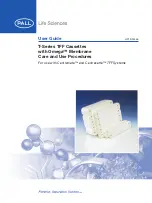
Page 18
www.omlet.co.uk
1. Worker Cells -
Small hexagonal
with a flat cap. These are the most
common cells in the hive and are
used for breeding worker bees.
Cell types
Inside the hive you will see different cells within the combs that the bees
construct. These cells vary according to their purpose as follows:
3. Queen Cells -
Large, thimble
shape and hang vertically. These
can appear at any time of year if
the bees are producing a queen,
although most common is spring
and early summer.
5. Pollen cells -
Pollen is stored by
the bees directly around the brood.
It comes in all sorts of different
colours depending on the plant it
was collected from.
2. Drone Cells -
Large hexagonal
with a domed cap. Only found in
the spring and early summer. More
often than not, drone cells are found
towards the bottom of a frame.
4. Nectar and honey cells -
These
are the same size as the cells used by
the bees for raising brood. Bees store
nectar in cells around the brood.
They will use this nectar as fuel while
they are working. They also convert
some of the nectar into honey which
they cap ( as in the cells in the top
left,) and for making bee milk.
Temperature control
The temperature of the brood is
critical. The eggs must be incubated
within 32-36
o
C, otherwise the bees
will not develop and hatch properly.
The worker bees control the
temperature by either fanning
their wings to cool the hive or by
metabolizing honey to heat it. The
brood also produces heat as the
larvae and pupae grow. If the colony
is too hot, the workers douse their
bodies in water and bring it into the
hive. They then fan the air with their
wings, thus bringing the temperature
down by evaporation. In cooler times, they huddle together around the
brood of eggs to keep it warm.
Bees fanning their wings.
Honey bee population
The population of the colony expands in the spring and
contracts in the autumn. Understanding this is the very essence
of beekeeping.
A typical colony will build up it’s population using the nectar of the
early spring flowers. Then, with a large workforce, it can harvest
the higher quality nectar in the summer. The colony reduces it’s
numbers in preparation for winter when around 10,000 bees will
cluster around the queen using the stored honey to keep warm until
the following spring when the cycle begins again.
This is the simple pattern that you will see in your own colony. The rise
in spring can be quite dramatic. Don’t forget a good queen will lay up to
2000 eggs a day so in a couple of weeks the population of the colony can
easily increase by 10,000 bees, even taking into account the older bees
dying. You should be careful not to be caught out by this and ensure that
the colony has plenty of space to expand into with new brood frames and
supers added as soon as the temperature increases enough to allow you
to open the Beehaus. There is more on managing the colony throughout
the seasons later in the guide.
Population Growth
You can see how the bee colony changes in size in the diagram below:
The queen will start laying in January but she really gets going from
March onwards. At this time, the colony is dedicated to the development
of the brood and the queen increases her egg laying accordingly. The
brood numbers peak around May/June. The ratios of adult bees to brood
at this time is around 2 to 1. The amount of food that is required by the
colony will, at this point, remain static and the bees can start intensively
storing nectar.
The overall bee population peaks around July / August and reaches it’s
lowest point around February / March as the over-wintering bees die.
60,000
Bee colony size
Adult bees
Swarming season
Brood
50,000
10,000
Jan Feb Mar Apr May Jun July Aug Sep Oct Nov Dec
20,000
30,000
40,000
















































